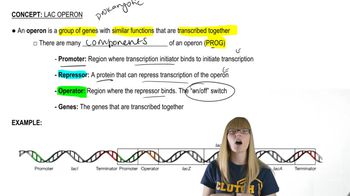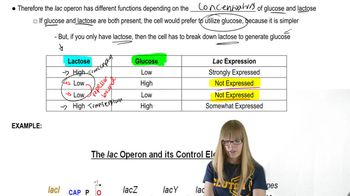Table of contents
- 1. Introduction to Genetics51m
- 2. Mendel's Laws of Inheritance3h 37m
- 3. Extensions to Mendelian Inheritance2h 41m
- 4. Genetic Mapping and Linkage2h 28m
- 5. Genetics of Bacteria and Viruses1h 21m
- 6. Chromosomal Variation1h 48m
- 7. DNA and Chromosome Structure56m
- 8. DNA Replication1h 10m
- 9. Mitosis and Meiosis1h 34m
- 10. Transcription1h 0m
- 11. Translation58m
- 12. Gene Regulation in Prokaryotes1h 19m
- 13. Gene Regulation in Eukaryotes44m
- 14. Genetic Control of Development44m
- 15. Genomes and Genomics1h 50m
- 16. Transposable Elements47m
- 17. Mutation, Repair, and Recombination1h 6m
- 18. Molecular Genetic Tools19m
- 19. Cancer Genetics29m
- 20. Quantitative Genetics1h 26m
- 21. Population Genetics50m
- 22. Evolutionary Genetics29m
12. Gene Regulation in Prokaryotes
Lac Operon
Problem 19e
Textbook Question
Textbook QuestionIn a theoretical operon, genes A, B, C, and D represent the repressor gene, the promoter sequence, the operator gene, and the structural gene, but not necessarily in the order named. This operon is concerned with the metabolism of a theoretical molecule (tm). From the data provided in the accompanying table, first decide whether the operon is inducible or repressible. Then assign A, B, C, and D to the four parts of the operon. Explain your rationale. (AE=active enzyme; IE=inactive enzyme; NE=no enzyme.) Genotype tm Present tm Absent A⁺B⁺C⁺D⁺ AE NE A⁻B⁺C⁺D⁺ AE AE A⁺B⁻C⁺D⁺ NE NE A⁺B⁺C⁻D⁺ IE NE A⁺B⁺C⁺D⁻ AE AE A⁻B⁺C⁺D⁺/F'A⁺B⁺C⁺D⁺ AE AE A⁺B⁻C⁺D⁺/F'A⁺B⁺C⁺D⁺ AE NE A⁺B⁺C⁻D⁺/F'A⁺B⁺C⁺D⁺ AE+IE NE A⁺B⁺C⁺D⁻/F'A⁺B⁺C⁺D⁺ AE NE
 Verified Solution
Verified SolutionThis video solution was recommended by our tutors as helpful for the problem above
Video duration:
1mPlay a video:
502
views
Was this helpful?
Related Videos
Related Practice



